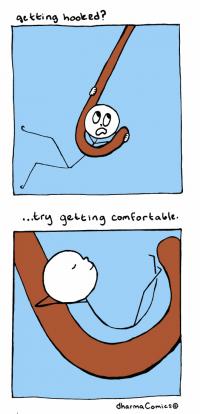The Trick is to Keep Seeing


(The Tibetan word shenpa) is usually translated “attachment,” but a more descriptive translation might be “hooked.” When shenpa hooks us, we’re likely to get stuck. We could call shenpa “that sticky feeling.” It’s an everyday experience. Even a spot on your new sweater can take you there. At the subtlest level, we feel a tightening, a tensing, a sense of closing down. Then we feel a sense of withdrawing, not wanting to be where we are. That’s the hooked quality. That tight feeling has the power to hook us into self-denigration, blame, anger, jealousy and other emotions which lead to words and actions that end up poisoning us.
[...]
In practicing with shenpa, first we try to recognize it. The best place to do this is on the meditation cushion. Sitting practice teaches us how to open and relax to whatever arises, without picking and choosing. It teaches us to experience the uneasiness and the urge fully, and to interrupt the momentum that usually follows. We do this by not following after the thoughts and learning to come back to the present moment. We learn to stay with the uneasiness, the tightening, the itch of shenpa. We train in sitting still with our desire to scratch. This is how we learn to stop the chain reaction of habitual patterns that otherwise will rule our lives. This is how we weaken the patterns that keep us hooked into discomfort that we mistake as comfort. We label the spinoff “thinking” and return to the present moment.
[...]
We could think of this whole process in terms of four R’s: recognizing the shenpa, refraining from scratching, relaxing into the underlying urge to scratch and then resolving to continue to interrupt our habitual patterns like this for the rest of our lives. What do you do when you don’t do the habitual thing? You’re left with your urge. That’s how you become more in touch with the craving and the wanting to move away. You learn to relax with it. Then you resolve to keep practicing this way.
Working with shenpa softens us up. Once we see how we get hooked and how we get swept along by the momentum, there’s no way to be arrogant. The trick is to keep seeing. Don’t let the softening and humility turn into self-denigration. That’s just another hook. Because we’ve been strengthening the whole habituated situation for a long, long time, we can’t expect to undo it overnight. It’s not a one-shot deal. It takes loving-kindness to recognize; it takes practice to refrain; it takes willingness to relax; it takes determination to keep training this way. It helps to remember that we may experience two billion kinds of itches and seven quadrillion types of scratching, but there is really only one root shenpa -- ego-clinging.
Pema Chödrön is widely known for her compelling and down-to-earth interpretation of Tibetan Buddhism for Western audiences.
Pema studied under the meditation master Chö​gyam Trungpa Rinpoche and is now the resident teacher at Gampo Abbey, Nova Scotia, the first Tibetan monastery for Westerners. The passage above comes from a longer article.
SEED QUESTIONS FOR REFLECTION: How have you worked with 'shenpa' in your own life and practice? Do any memorable instances come to mind? How do you overcome challenges and remain committed to seeing, and staying the course?
Add Your Reflection
3 Past Reflections

On May 1, 2018 laddu wrote :
The writing of this article is good...THANKS KEEP ON SHARING SUCH BEAUTIFUL INFORMATIONS
Post Your Reply

On Dec 9, 2015 j wrote :
The resolve is the hard part.
I opened this page now because of losing the energy, the upsetness over losing a friend to what I call her ego and what she calls my ego.
For now, I hope I get my energy back. She won't listen to my advice. Is it too much for me to give advice?
Post Your Reply
